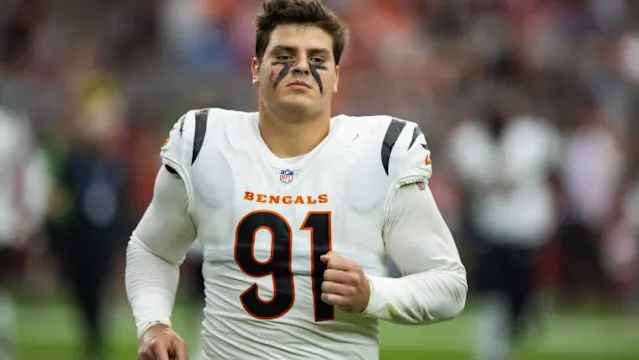The Cincinnati Bengals are one of the NFL’s most intriguing franchises in 2025, known for blending offensive fireworks with an ever-developing defensive identity. However, their latest move—or rather, their lack of movement—has raised significant questions about where their organizational priorities lie. Specifically, the ongoing standoff with Pro Bowl defensive end Trey Hendrickson has fueled frustration among fans and analysts alike. While the Bengals may have put the Shemar Stewart contract fiasco behind them, their refusal to offer clarity or finality on Hendrickson’s future may now present an even greater threat to their trajectory. As training camp barrels forward and the regular season inches closer, Cincinnati’s leadership finds itself at a crossroads: do they double down on youth and uncertainty, or finally show their stars the respect and commitment needed to contend in the ultra-competitive AFC?
Trey Hendrickson has been one of the most impactful pass rushers in the league since arriving in Cincinnati from New Orleans in 2021. A sack machine with relentless energy and a nose for the football, he’s been an integral part of the Bengals’ defensive revival. In 2022 and 2023, Hendrickson was arguably the team’s most consistent playmaker on the defensive line, drawing double-teams, forcing turnovers, and bringing down elite quarterbacks with tenacity. His presence created opportunities for the rest of the front seven and allowed Lou Anarumo’s defense to play aggressive, unpredictable football. Yet despite his production and leadership, the team seems to be dragging its feet regarding his status and compensation. This indecisiveness has now boiled over into a highly visible standoff.
The Bengals’ front office may point to salary cap concerns or the broader business of roster construction to justify their hesitancy, but such arguments ring hollow when viewed through the lens of Hendrickson’s performance. The truth is, few edge rushers have offered the consistency and explosiveness that he has in the past three seasons. And for a team that prides itself on building through player development and rewarding homegrown or well-integrated talent, allowing a player like Hendrickson to feel undervalued sends a troubling message. One could argue that the team is prioritizing long-term flexibility over short-term contention, but with Joe Burrow in his prime and Ja’Marr Chase approaching a megadeal, that strategy becomes harder to defend.
What makes this entire ordeal even more perplexing is how uncharacteristic it seems for a franchise that has finally climbed out of the NFL’s basement in recent years. From the 2021 Super Bowl run to the 2023 playoff surge, the Bengals had seemingly shed their old ways of mismanagement and near-misses. They were finally operating like a modern football powerhouse: focused, aggressive, and team-first. But Hendrickson’s limbo suggests a regression to the organizational inertia that once plagued them. It’s not just a matter of dollars and cents—it’s about optics, messaging, and the morale of a locker room filled with players who watch how veterans are treated. If someone as essential as Trey Hendrickson can be left in the cold, what does that say to the rest of the team?
From Hendrickson’s perspective, the frustration is entirely warranted. While he’s not holding out in the traditional sense, his absence from certain team activities and growing tension around his future indicate a brewing dissatisfaction. He’s reportedly been open about wanting a restructured deal or an extension that reflects his value, especially as younger, less proven edge rushers around the league ink massive contracts. In a league where health and availability are never guaranteed, players like Hendrickson are understandably protective of their earning windows. His play has more than justified his demands, and his leadership on and off the field has helped mold a young Bengals defense into a formidable unit.
What’s more, the Bengals are not in a talent-rich position where they can afford to alienate someone like Hendrickson. Yes, they have promising prospects in the pipeline, including the likes of Myles Murphy and Cam Sample, but none have proven they can deliver on the same level. Relying on potential over proven production is always a dangerous gamble in the NFL, especially when you’re trying to maximize a championship window. In short, if the Bengals hope to hang with the Chiefs, Bills, and Ravens come playoff time, they need all hands on deck—and Hendrickson is a critical hand.
The ripple effects of the standoff are already being felt in the locker room and among fans. While Burrow, Chase, and other stars toe the company line in public, there’s a growing sense that something is amiss. This kind of situation can quickly snowball, especially if Hendrickson decides to sit out meaningful time or reduce his engagement. The Bengals are a team that relies on chemistry and continuity, and allowing discontent to fester around a respected veteran threatens both. Fans, too, are starting to vocalize their concerns. Social media platforms and talk radio have become battlegrounds for debates about the team’s commitment to winning versus penny-pinching. The city of Cincinnati, which has thrown its full support behind this golden generation of Bengals, is watching closely.
It’s important to understand that Hendrickson is not merely a good player—he’s an identity piece. His motor, edge, and production have helped shape the tone of this defense. Much like Vontaze Burfict once gave the Bengals an edge, or how Geno Atkins anchored the line a decade ago, Hendrickson’s presence sets a standard. Replacing that isn’t just about finding someone who can notch sacks. It’s about replacing leadership, experience, and football IQ. That’s not something you plug in from the draft or sign off the street. The Bengals seem to be underestimating how difficult it would be to move on from such a player without suffering a steep decline on defense.
From a broader NFL perspective, the Hendrickson saga also raises questions about how teams manage their cap space in the modern game. The Bengals are known for being relatively conservative with contract structures, preferring upfront guarantees and low long-term risk. But that model may no longer be sustainable in an era where top-tier talent expects—and often demands—market-setting deals. Organizations that adapt to this new landscape thrive; those that don’t risk alienating their stars and losing competitive ground. Cincinnati has spent years shedding the reputation of being frugal to a fault. Allowing this dispute to linger undercuts that progress and opens the door for critics to say, “same old Bengals.”
There is still time to right the ship. Hendrickson has not formally requested a trade, and the team has not shut the door on future negotiations. But as each day passes, the situation becomes more entrenched and harder to walk back. The best path forward is clear: sit down, find common ground, and reward a player who has given his heart, body, and prime years to the team. Doing so would not only reinforce the locker room’s trust in management but also signal to the league that the Bengals are serious about their contention window. Failing to act could have the opposite effect—fueling division, reducing performance, and eventually leading to Hendrickson’s departure.
What the Bengals must also consider is the domino effect this could trigger. If Hendrickson is shown the door or allowed to feel expendable, it may influence other veterans’ willingness to re-sign or recruit others to Cincinnati. In today’s NFL, where peer influence and word-of-mouth weigh heavily on free-agent decisions, perception matters immensely. The Bengals have worked hard to create a player-friendly, team-first culture. Keeping Hendrickson in limbo threatens that culture. It sets a precedent that excellence does not guarantee loyalty, and that’s a dangerous slope for any organization—let alone one trying to build a dynasty.
It’s also worth noting that Burrow, though reserved and diplomatic in public, is known to value toughness and accountability in his teammates. Hendrickson has earned his quarterback’s respect through years of elite-level play. If this saga sours their relationship or undermines Burrow’s belief in the team’s leadership, the consequences could be seismic. A franchise quarterback needs to believe the front office will do everything in its power to keep the roster competitive and the locker room unified. Playing hardball with a star defender, especially one that lines up for battle every Sunday, is a risky way to instill confidence.
Ultimately, this is a moment of truth for the Bengals. How they handle Trey Hendrickson’s situation will echo far beyond this season. It will tell the league and its own roster what values guide their decision-making. Are they a team that rewards loyalty and performance, or one that pinches pennies and gambles on unknowns? With so much at stake and a Super Bowl window open, the right choice should be obvious. Pay your stars. Keep your core intact. And don’t let avoidable drama derail a promising future. If Cincinnati gets this wrong, it won’t be for lack of warning signs—it’ll be a conscious decision to prioritize cap space over championship pedigree. And in the NFL, such decisions rarely age well.



